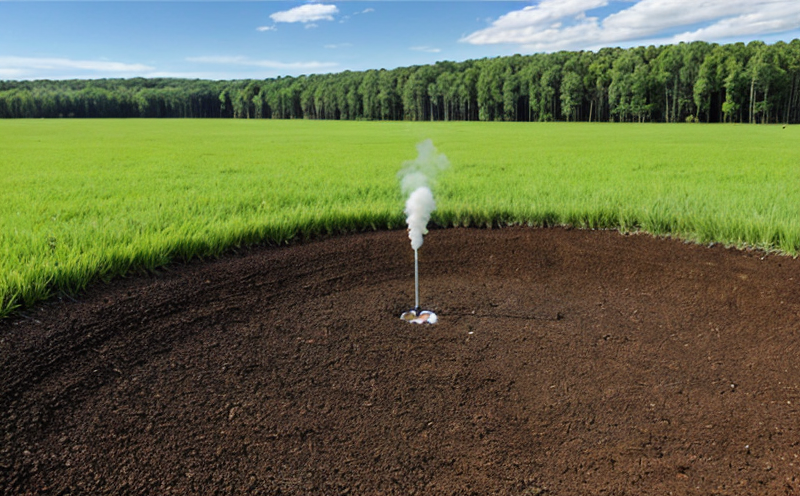ASTM E1912 Environmental Risk Assessment Testing for Mining Projects
The ASTM E1912 standard provides a comprehensive framework for assessing and mitigating environmental risks in mining projects. This service is essential for ensuring that mining operations comply with international standards, protect ecosystems, and minimize adverse impacts on the environment.
Environmental risk assessment testing under ASTM E1912 involves identifying potential risks to flora and fauna, water bodies, air quality, soil, and other environmental factors during various stages of a mining project. This includes pre-approval assessments, operational monitoring, and post-closure evaluations. The methodology is designed to be robust and adaptable to the unique characteristics of each mining site.
The testing process typically involves several key steps: initial risk identification, exposure pathway analysis, dose-response modeling, and risk characterization. Each step requires careful planning and execution to ensure accurate assessment results. For instance, in a typical project, the first phase may involve mapping out areas likely affected by the mine, followed by detailed field surveys and laboratory analyses.
The standard emphasizes the importance of stakeholder engagement throughout the process, ensuring that local communities, regulatory bodies, and other interested parties are informed about potential environmental impacts. Compliance with ASTM E1912 is crucial for mining companies aiming to secure permits and licenses, as well as to maintain a positive reputation in the industry.
The testing protocols outlined in ASTM E1912 are designed to be rigorous yet practical, allowing for flexibility based on local conditions and project specifics. This ensures that environmental risks are effectively managed without unduly hindering mining operations. The service provided here includes full support from sample collection through final report delivery, ensuring clients receive detailed insights into their projects' environmental impact.
To achieve the best results with ASTM E1912 testing, it is important to engage experienced professionals who understand both the technical aspects of the standard and its broader implications for mining operations. Our team comprises experts familiar with various mining sectors and capable of tailoring our approach to meet specific project needs.
Scope and Methodology
The ASTM E1912 scope encompasses a wide range of environmental risk assessment activities relevant to mining projects. It covers all phases from initial planning through closure, addressing potential impacts on air quality, water resources, soil health, and biodiversity.
The methodology involves several critical components:
- Initial site characterization
- Evaluation of exposure pathways
- Dose-response modeling for various pollutants
- Risk characterization and communication
This structured approach ensures thorough evaluation of environmental risks before, during, and after mining activities. We employ state-of-the-art equipment and methodologies to gather accurate data, which forms the basis of our risk assessments.
For instance, initial site characterization might involve collecting soil samples for heavy metal analysis or analyzing nearby water sources for contamination levels. Exposure pathway evaluations consider how pollutants can move through different environmental mediums (air, water, etc.) affecting various receptors like plants and animals. Dose-response modeling helps quantify the relationship between pollutant concentration and adverse effects on living organisms.
Risk characterization integrates all these elements into a comprehensive report that identifies significant risks and recommends mitigation strategies. Communication is key here, ensuring that findings are clearly presented to stakeholders in ways they can understand and act upon. Our methodology adheres strictly to ASTM E1912 guidelines while incorporating best practices from related standards like ISO 14001 for environmental management systems.
Benefits
The benefits of implementing ASTM E1912 Environmental Risk Assessment Testing in mining projects are numerous and far-reaching. By adhering to this standard, mining companies not only meet regulatory requirements but also enhance their operational efficiency and sustainability.
Firstly, compliance with ASTM E1912 ensures that environmental risks are systematically identified and addressed, reducing the likelihood of costly penalties or project delays due to non-compliance. Secondly, proactive risk assessment helps minimize actual environmental impacts, fostering a responsible corporate image among stakeholders and the public.
A second key benefit is enhanced operational efficiency through better-informed decision-making processes. By understanding potential risks early in the project lifecycle, mining firms can optimize resource allocation, reduce waste generation, and improve overall productivity. Furthermore, this service supports sustainable development goals by encouraging practices that protect natural resources for future generations.
Another significant advantage lies in improved stakeholder relations. Transparent communication about environmental impact assessments fosters trust between companies and local communities, regulatory authorities, and other interested parties. This strengthens relationships and facilitates smoother interactions during project implementation and beyond.
The long-term benefits extend to financial savings as well. Early identification of risks allows for targeted interventions that prevent costly remediation efforts later on. Additionally, adherence to best practices outlined in ASTM E1912 can attract investors looking for responsible corporate citizenship, potentially opening up new funding opportunities.
Use Cases and Application Examples
| Project Phase | Risk Assessment Focus | Main Findings | Mitigation Strategy |
|---|---|---|---|
| Pre-Approval Stage | Evaluating potential impacts on local flora and fauna | Identified significant risk of habitat disruption due to mining activities. | Implemented a buffer zone around critical habitats. |
| Operational Monitoring | Monitoring air quality near the mine site | Detected elevated levels of particulate matter and sulfur dioxide emissions. | Installed additional pollution control equipment to reduce emissions. |
| Post-Closure Evaluation | Evaluating long-term effects on nearby water bodies | Observed gradual improvement in water quality over time. | Continued monitoring and ongoing maintenance of the area. |
The above table illustrates how ASTM E1912 can be applied across different stages of a mining project. Pre-approval assessments help identify potential risks early, operational monitoring ensures continuous compliance, while post-closure evaluations assess long-term impacts and effectiveness of implemented mitigation measures.





